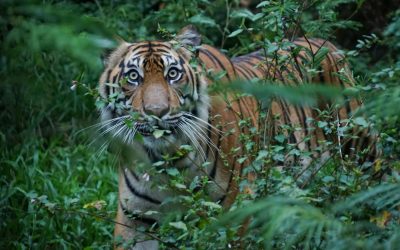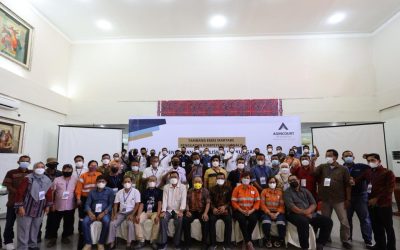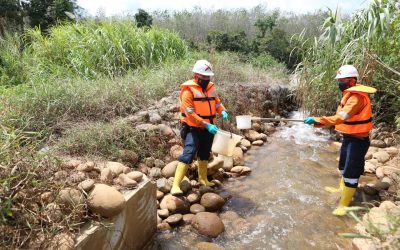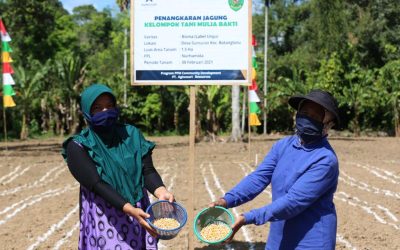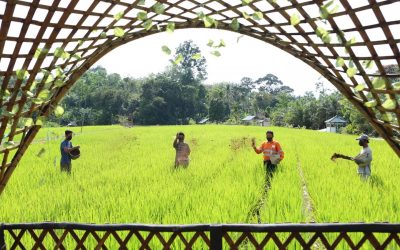Earth provides so many materials to be managed by humans, whether it is on the surface such as plants or underground such as various minerals that can be useful for humans. Good mine management to get the earth’s wealth below the surface supports the socio-economic development of the community and the environment around the mine. And if managed responsibly and efficiently, mining businesses can support the conservation and protection of biodiversity and ecosystems.
Biodiversity is the key to the life of an ecosystem. Biodiversity includes species richness and ecosystem complexity so that it can affect the community of organisms, the development and stability of the ecosystem. The extinction of one species affects the order of the entire ecosystem. PT Agincourt Resources (PTAR) as a company engaged in the mining sector has strong integrity with biodiversity. The company that operates the Martabe gold mine in Batangtoru, Central Tapanuli, North Sumatra is committed to protecting biodiversity in running its business. The form of this commitment is in the form of a company’s biodiversity policy that has been and will continue to be realized in the future.
Although the mining business still has an environmental impact and requires a lot of energy, however, as stated by the Instituto Brasileiro de Mineracao (IBRAM) in Mining and Green Economy, mining also makes a significant socio-economic contribution. It is undeniable that mining contributes to the growth of Gross Domestic Product (GDP), encourages the growth of investment in infrastructure and logistics, technology development, and increases the qualifications of professionals and is even able to increase the Human Development Index in the areas around the mine. In this case, PTAR embraces the community to jointly improve the capabilities of the young generation in improving the quality of individuals. PTAR has supported the construction of various facilities such as libraries, cultural buildings, health facilities, mini-hydropower plants and many more.
When managed properly, mining products can support the socio-economic development of the surrounding community. And if managed responsibly, mining businesses can also encourage environmental and ecosystem conservation, and maintain them while they are still operating and afterward. Regarding the two sides of the impact of mining, it is clear that the company’s efforts to gain profits without neglecting the interests of the community and the environment can only be made by managing the mining area responsibly. In Indonesia, this effort is regulated in Law No. 4 of 2009 concerning Mineral and Coal Mining (UU Minerba) which states that mining activities must be sustainable and environmentally sound.
Many examples of the contribution of mining companies to society and the environment may appear as mere Corporate Social Responsibility (CSR) so that they seem to fulfil obligations and not just kindness. When referring to ISO 26000, the position of CSR at the international level has shifted from just sharing profits to becoming an integral part of the company’s sustainable business.
Serious in Preserving Biodiversity
Seriousness in supporting ecosystem and biodiversity conservation efforts is proven by concrete actions by PTAR.
The company under PT Astra International Tbk has even formed the Environment Department, a department that handles the environment and biodiversity and embraces parties such as academics, researchers, local governments, communities, environmentalist organizations and the Ministry of the Environment.
The Environment Department at PT Agincourt Resources (PTAR) is tasked with reforesting the remaining land undermining management and revitalizing the ecosystem inhabited by various species, not only plants but also animals. In principle, if plants can grow well and provide shelter and food for animals, other species will come. PTAR Environment Department has sown thousands of tree seedlings in nursery facilities of local species and distributed them to the community free of charge. For ex-mining areas, the types planted are trees that can grow quickly such as sengon and monkeypod trees as shade plants that can also fix nitrogen to increase fertility. Some types of plants do not grow well in open areas.
Not only sowing plant species that are widely available in Batangtoru area, personnel from the Environment Department regularly enter the forest and if they find seeds of unique and rare species, but they will also take the seeds to the nursery facility and provide special treatment to preserve the plant seeds.
“We don’t just sow tree seeds that are abundant in nature, we also sow and treat with special care some of the rare species that we encounter when we walk into the forest,” said Fitri Rahmadani, staff of PTAR Environment Department.
To reforest a land, apart from planting seeds that have been sown in polybags and formed as small trees, they also sow seeds/seed balls from plants such as forest rambutan, kemayau and torop. They do not just sow seeds, but they also do the monitoring. The seed balls are sown at different angles of the slope of the land, and then observed whether the seed balls break when they hit the ground or are well planted or cracked due to a layer of rock. Rainfall that watered the reforestation area was also recorded. Periodically the germinated seed balls are recorded, monitored and treated so that they can grow as adult plants.
PTAR’s success in cultivating ex-mining land can be seen from the presence of many animal species in the new ecosystem that is formed from tree seedlings produced by the PTAR environment department. Every species that comes to and lives in the new ecosystem that is reforested by PTAR is monitored, recorded and documented. These animals are various types of birds such as Rufous-Tailed Tailorbird (Orthotomus sericeus), purple-naped sunbird (Hypogramma hypogrammicum), Oriental magpie-robin (Copsychus saularis), black-naped monarch (Hypothimis azurea), fluffy-backed tit-babbler (Macronous ptilosus) to various types of frogs such as green frog (Hylarana erythraea), Asian toad (Duttaphrynus melanostictus), commom frog (Hylarana nicobariensis), file-eared tree frog (Polypedates otilopus), striped tree frog (Polypedates leucomystax) and also mammals such as long-tailed macaques, pythons, forest goats, Manouriaemys and Amydacartilagenia turtles. Types of trees that are planted and can restore soil fertility so that they can provide new habitats for many of these species ranging from sengon, hibiscus, red meranti to durian. There are also local endemic plants such as Styrax Paralleloneurum or toba frankincense which grows a lot in the Tapanuli area. The presence of fauna in reforestation areas is encouraging evidence of efforts to maintain biodiversity.
Sustainability is an Integral Part of Business
PTAR Environment Department’s attention to sustainability and ecosystem preservation is such detailed to restore and pass on biodiversity to future generations and become a sustainable mining company. PTAR’s strong commitment to biodiversity is also supported by PTAR’s commitment to improving community welfare and encouraging the growth of the Human Development Index in the areas around the mine. PTAR views that if the community is prosperous and has the knowledge and skills to face competition in the world of work, then the community will not look for a livelihood in the forest. With good counselling and communication to the community, PTAR invites and supports every effort to protect forests and ecosystems because for PTAR, nature conservation and maintaining biodiversity are an integral part of the business.
PTAR avoids cutting down trees unnecessarily even if it is in a mining area. If forced to cut down, the Department of Environment already has a plan to reforest the area. In terms of land clearing even though it is within the management boundary area, PTAR adheres to a fairly conservative principle. Considerations and calculations are prepared with in-depth studies and researches. The approval of various parties as well as the Ministry of Environment was submitted long before the land clearing. Even though it is quite far from Batangtoru forest, PTAR also always supports efforts to protect and preserve the forest and river habitat of Batangtoru. PTAR provides free seedlings for reforestation efforts on each land, holds seminars and outreach to the community around the mine about the importance of biodiversity that supports the lives of many residents in Batangtoru area.
PTAR does not stop returning “debt” to nature by only focusing on flora, PTAR also cooperates with wild animal breeding centers, and the North Sumatra Natural Resources Conservation Center (BBKSDA) to preserve wild animals trapped or illegally kept by residents.
If the stakeholders, hand in hand with mining companies and the community are able to hold on to the above commitments, without underestimating critical attitudes and voices, also paying attention to the impact on society and the environment while mining is taking place, environmental sustainability and environmentally friendly mining can go hand in hand without producing damage. If the future of the environment depends on mining companies, at the same time the public also has the same responsibility to keep all their promises and commitments. ***


